Abstract
In this paper, a wavelength-selectable erbium-doped fiber (EDF) laser in L-band bandwidth with a simple structure and low cost is described. To obtain stable single-longitudinal-mode (SLM) and narrow laser linewidth, the 2 m unpumped EDF-based saturable absorber (SA) and 100 m single-mode fiber (SMF)-induced Rayleigh backscattering (RB) injection effect are cascaded in the ring cavity of the fiber laser. The EDF SA and feedback RB injection can cause the auto-tracking ultra-narrow bandwidth filter effect to suppress the multiple longitudinal mode oscillations and narrow the laser linewidth. Thus, the tunable SLM wavelength output of the EDF laser with sub-kHz linewidth can be achieved. In the measurement, two EDF ring lasers can be executed when the placement of EDF-based SA and SMF-induced RB are switched to experiment with different output characteristics. The experimental results show that the wavelength bandwidths of the two lasers are between 1558.0 and 1618.0 nm. Additionally, the optimal optical signal-to-noise ratio (OSNR), wavelength linewidth, output power, and stability of the presented EDF laser configuration are also achieved and discussed.
1. Introduction
To obtain the stable single-longitudinal-mode (SLM) output, fiber lasers have been designed with several constructions, such as the distributed feedback (DFB) [], distributed Bragg reflector laser (DBR) [], and typical linear and fiber ring cavities [,]. As mentioned above, the fiber ring lasers are the most important, because the ring cavities possess the capability to evade spatial gain hole-burning in the linear fiber cavity by applying an intra-cavity isolator and allow us to insert more optical devices for specific operations []. Therefore, erbium-doped fiber (EDF) lasers exhibit output characteristics, such as narrow linewidth, high optical signal-to-noise ratio (OSNR), low phase noise, single-longitudinal-mode (SLM) and long coherence length [,]. Due to the above-mentioned properties, the EDF lasers can also be used in many fields and applications, such as optical sensors, optical communications, bio-photonics, microwave (MW) photonics, optical spectroscopy, and instrumentations [,,,,]. However, the homogeneous broadening of erbium, mode-hopping, and long fiber cavity length could lead to multi-longitudinal-mode (MLM) oscillation which exists in fiber lasers []. Thus, to solve and eliminate the MLM noise of the EDF laser, different technologies have been proposed [,,,,], such as using the unpumped EDF saturable absorber (SA), multiple fiber ring structure, utilizing narrowband fiber Bragg gratings (FBGs), inserting Rayleigh backscattering (RB) injection, and applying a Mach–Zehnder interferometer (MZI)-based filter to the fiber cavity.
To select and tune the various wavelength outputs in the EDF-based laser configuration, the variable FBG [], Fabry–Perot tunable filter (FP-TF) [], and tunable bandpass filter (TBF) [] have been added to the fiber ring resonator for tuning wavelength. Furthermore, the achievable wavelength selection bandwidth of fiber laser depends on the effective gain medium range of erbium ion. To achieve broadband wavelength-tuning scope, using the broadband erbium-doped fiber amplifier (EDFA) [], two parallel EDFAs [] and a hybrid optical amplifier [] were applied inside the laser cavity as the gain medium.
In 2015, Li et al. proposed a fiber ring laser architecture using an MZI design, which consisted of two parallel fiber rings that shared the unpumped doped saturable absorber (SA) and fiber Bragg grating (FBG) for SLM oscillation []. The MZI-based comb-based filter and unpumped SA-induced auto-tracking narrow bandwidth filter could achieve the linewidth output of 1.09 kHz. In 2013, Feng et al. demonstrated an EDF laser by applying the cascaded Type I and Type II fiber ring secondary cavities to achieve SLM operation based on the Vernier effect to lead to the mode-filter operation in order to reduce the multiple longitudinal modes []. But the actual output linewidth of that EDF laser was not performed and discussed experimentally in their work. In 2017, Lu et al. also presented a fiber compound ring laser, which was composed of a fiber optical tunable filter, a high-finesse ring filter, and a loop mirror filter, to provide a narrow filter performance and also obtain the average 3 dB linewidth of 8.8 kHz over 60 nm wavelength tuning range []. In 2007, to reach an output linewidth of 2.5 kHz, In 2007, Cheng et al. used a narrow optical filter, which was constructed with an apodized FBG and a high finesse FBG-based Fabry–Perot (FP) etalon, inside the fiber ring cavity to decrease the dense longitudinal mode noises []. In 2015, Gu et al. applied Rayleigh backscattering (RB) in a tapered fiber with feedback injection in a ring cavity. The feedback RB injection ring laser cavity also needed a sub-ring architecture to suppress and narrow the output linewidth to sub-kHz []. Moreover, He et al. used the MZI-based filter, Sagnac ring resonator effect, and optical tunable filter in the ring cavity to achieve tunable wavelength output with 3 dB linewidth of 0.02 nm (~2.5 GHz) in C-band operation bandwidth []. Therefore, although all the above methods can achieve stable SLM operation, most of them can only obtain kHz-level linewidth output.
In this paper, we designed a fiber ring laser configuration by utilizing an L-band EDFA as a gain medium for stable and tunable SLM wavelength output. To generate and maintain a constant SLM process and narrow linewidth output, a short length of 2 m EDF-based SA and a 100 m single-mode fiber (SMF) induced RB effect were combined in cascade in the fiber ring cavity. In the measurement, we exchanged the positions of EDF-based SA and SMF-induced feedback RB to result in two EDF ring laser structures. Here, we also performed the various output appearances of the two fiber laser architectures designed. To tune and select different wavelength outputs with SLM behavior, a wideband tunable bandpass filter (TBF) was added to the ring cavity for continuous tuning. In this experiment, the wavelength tunability of two presented EDF lasers started at a wavelength of 1558.0 nm and ended at 1618.0 nm (obtainable bandwidth = 60 nm). The measured OSNR and output power of the first and second EDF laser architectures were from 46.72, 68.44 dB, and 49.09 to 68.71 dB; and −14.73, 0.78 dBm, and −14.17 to 1.74 dBm over the achievable selection range, respectively. And all the achieved 3 dB Lorentzian linewidths for both presented EDF lasers were 313 Hz. This means that the cascaded EDF-SA and feedback RB injection could result in a narrow laser linewidth. Additionally, the output stabilities of power and center wavelength of the two lasers were less than 0.47 and 0.22 dB/40 min and 0.032 and 0.024 nm/40 min, respectively. Compared with previous studies [], the presented EDF laser can reach better sub-kHz linewidth output and wide wavelength by adjusting the bandwidth. As a result, the proposed L-band EDF laser has a simple architecture and low cost and achieves a broad tuning bandwidth of 60 nm, stable SLM wavelength, and narrow linewidth output.
2. First EDF Laser Experiment
Figure 1 exhibits the first presented L-band EDF laser structure, which is built using an L-band commercial erbium-doped fiber amplifier (EDFA), a polarization controller (PC), a three-port optical circulator (OC), an unpumped EDF of 2 m long, a tunable bandpass filter (TBF), a single-mode fiber of 100 m long, a fiber mirror reflector (FMR) and 1 × 2 10:90 optical coupler (CPR), respectively. In this laser architecture, a single fiber ring is employed to produce a laser resonant cavity. The commercial L-band EDFA is added in the ring cavity as the gain medium. The available gain scope of initial EDFA, which has 11 dBm saturation power, is from 1568 to 1604 nm [Bandwidth (BW) = 36 nm bandwidth]. To cause various wavelength outputs of the EDF laser, the passband of TBF can be adjusted for continuous tuning. The TBF with 6 dB insertion loss has an available tuning scope between 1510 and 1630 nm. A PC is adapted to control the polarization status and attain the largest output power of each lasing wavelength. The OC fixes the transmission direction of the lasing lightwave clockwise, as shown in Figure 1. The generated wavelength passes through the OC (port 1 → port 2), 100 m SMF, 2 m unpumped EDF, and FMR, respectively, and then returns to the EDFA via the same optical elements. Moreover, the output spectrum of the presented EDF laser is detected through the 10% connected port of CPR by an optical spectrum analyzer (OSA) with a 0.095 nm resolution for observation in the experiment, as also plotted in Figure 1. The measurable wavelength bandwidth of an OSA is from 600 to 1750 nm. The output power of each generated wavelength can also be detected by the OSA.
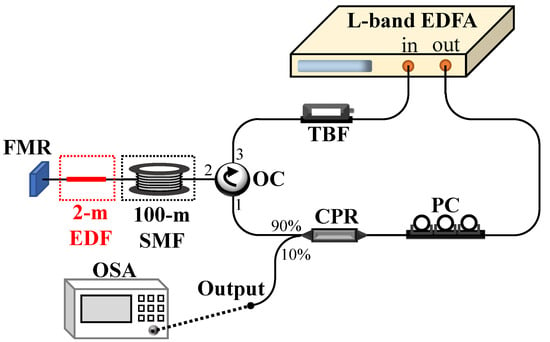
Figure 1.
Optical setup of first presented L-band EDF ring laser. PC: polarization controller; OC: optical circulator; EDF: erbium-doped fiber; FMR: fiber mirror reflector; CPR: 10:90 and 1 × 2 optical coupler; TBF: tunable bandpass filter; SMF: single-mode fiber; OSA: optical spectrum analyzer; EDFA: erbium-doped fiber amplifier.
3. Results and Discussion
First, the initial amplified spontaneous emission (ASE) curve of L-band EDFA measured was in the wavelength scope from 1553 to 1563 nm, as exhibited in Figure 2a. In the observation, the L-band ASE spectrum seemed relatively flat. The 6 dB bandwidth (BW) of the ASE spectrum was in the range from 1568.0 to 1609.5 nm (BW ≅ 41.5 nm). The 6 dB ASE bandwidth was close to the operative gain range of L-band EDFA (1568 to 1604 nm). When we initially adjusted the passband of TBF, the output wavelength of the proposed EDF laser configuration was generated from 1558.0 nm. Hence, all the output wavelengths could be achieved in a range from 1558.0 to 1618.0 nm, when the five wavelengths of 1558.0, 1573.0, 1588.0, 1603.0, and 1618.0 nm were selected for representation, respectively, as shown in Figure 2b. The wavelength excited at 1558.0 nm could not effectively suppress the ASE background noise after the wavelength of 1568 nm, as seen in Figure 2b. This is due to less gain competition on either side of the effective gain distribution of the presented EDF laser. This is why the high ASE background noise near the 1568 nm wavelength could not be suppressed. As the tuning wavelength gradually shifted to longer wavelengths, the ASE background noise could be more completely suppressed, as also exhibited in Figure 2b.
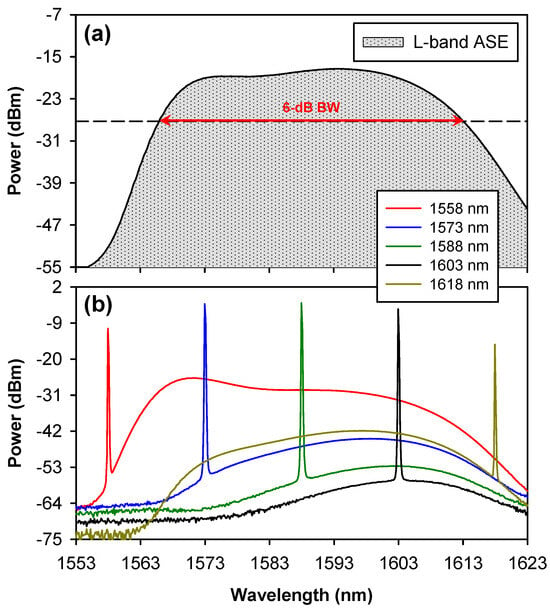
Figure 2.
(a) Measured initial ASE spectrum of EDFA in the L-band range. (b) Observed optical output spectra in a wavelength range of 1558.0 to 1618.0 nm.
Figure 3 also presents the optical signal-to-noise ratio (OSNR) and output power detected for this EDF ring laser at different lasing wavelengths, from 1558.0 to 1618.0 nm. The output power and OSNR of the EDF laser were between −14.73 and 0.78 dBm and 46.72 and 68.44 dB, respectively, within an available wavelength-tuning bandwidth of 60 nm. The largest and lowest output power of 0.78 and −14.73 dBm was at the lasing wavelength of 1578.0 and 1618.0 nm with OSNR of 64.39 and 54.50 dB, respectively. However, the minimum OSNR of 46.72 dB was at the output wavelength of 1558.0 nm. Moreover, a flat power output profile with 1.01 dB power fluctuation [ΔP = 1.01 dB (Pout = −0.23~0.78 dBm)] could also be reached over a useful bandwidth from 1568.0 to 1598.0 nm (BW = 30 nm) and the corresponding OSNR was between 61.66 and 68.44 dB, as displayed in Figure 3. Due to the flattened ASE and gain distribution of the original L-band EDFA, the presented EDF laser could also reach a flat power output bandwidth of 30 nm. In general, to achieve flattened power output operation of the fiber laser, adjusting the pump power of the laser diode (LD) of EDFA and using the corresponding optical filter were the common methods. This also means that the proposed laser does not require other controls and operations to achieve flat power output.
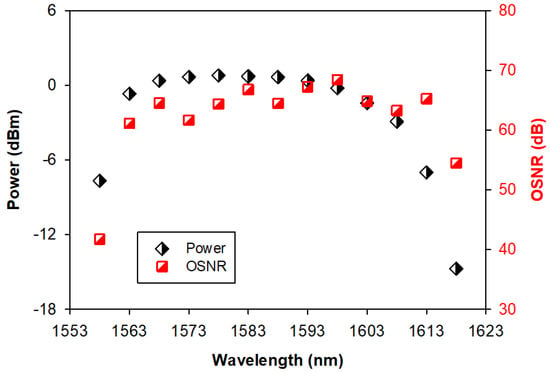
Figure 3.
Measured output power and OSNR of the demonstrated first EDF laser over the wavelengths from 1558.0 to 1618.0 nm.
In a previous investigation, the unpumped EDF-SA of 2 m long causes the auto-tracking filter with an ultra-narrow bandwidth effect, filtering and suppressing the dense longitudinal modes []. Therefore, the most longitudinal modes are removed by this SA-induced filter effect. We also applied a short length of 100 m SMF in the laser architecture to produce Rayleigh backscattering (RB) injection to narrow the laser linewidth. Essentially, when the wavelength of the laser wavelength is larger than the particle’s radius, the RB occurs [,]. The reflected RB light and lasing wavelength enter the EDFA simultaneously. Then, the amplified lasing wavelength can also generate the RB lightwave again with a higher Rayleigh coefficient to narrow the lasing wavelength. Moreover, the RB light enters the EDFA thousands of times to be excited and amplified. Therefore, the output linewidth of the EDF laser is compressed and narrowed to achieve stable SLM and sub-kHz linewidth output.
As mentioned above, the cascaded unpumped EDF-based mode-filter effect and SMF-induced RB feedback injection can also decrease the MLM oscillations and narrow linewidth performance. Therefore, we confirmed the SLM performance of the proposed first EDF laser system utilizing the delayed self-homodyne measurement. The trial setup was constructed by a dual-arm Mach–Zehnder interferometer (MZI) with two 1 × 2 and 50:50 CPR, a PC, and a 73 km single mode fiber (SMF) as a delay line, as illustrated in Figure 4. And the self-homodyne setup was without using acousto-optic modulator (AOM). As seen in Figure 4, each selected output wavelength enters the MZI setup and then the 10 GHz PIN photodiode (PD) to generate a beat signal. Then, the beat signal is converted to an electrical signal through the PD and observed using a 3 GHz BW electrical spectrum analyzer (ESA). Hence, Figure 5a shows the electrical output spectrum of the lasing wavelengths from 1558.0 to 1618.0 nm detected at 5 nm measurement intervals in the frequency range from 0 to 1000 MHz through the ESA. Here, we did not observe any longitudinal mode oscillations within the 1000 MHz RF bandwidth at the thirteen selected wavelengths, as seen in Figure 5a. The experiment results show that the demonstrated EDF ring laser architecture can lead to the SLM output. In addition, when we reduced the observing bandwidth to 80 MHz, the detected electrical spectra of the thirteen wavelengths also remained unchanged at stable SLM operation, as shown in Figure 5b. During a 40 min monitoring period, the measurement results also remained the same as above.

Figure 4.
The experimental setup of dual-arm MZI for delayed self-homodyne (without AOM) and self-heterodyne measurement (with AOM), respectively.
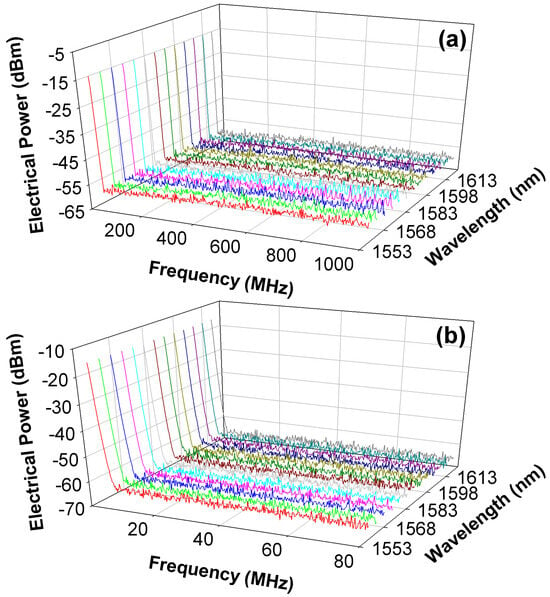
Figure 5.
Detected electrical spectrum of the wavelengths from 1558.0 to 1618.0 nm at 5 nm measurement intervals in the frequency range from (a) 0 to 1000 MHz and (b) 0 to 80 MHz by self-homodyne observation, respectively.
Then, we employed the delayed self-heterodyne method through the same MZI setup to measure the linewidth of the first EDF laser, as displayed in Figure 4. In the measurement, a 55 MHz shift frequency (fshift) was applied to the acousto-optic modulator (AOM) to generate the beat signal for linewidth detection. The PC was applied to control and attain the optimal beat signal performance for the experiment. Primarily, a lasing wavelength of 1618.0 nm was utilized for self-heterodyne setup for measurement. The electrical linewidth spectrum measured at the wavelength of 1618.0 nm at a center frequency of 55 MHz is shown as the red square symbol at the top of Figure 6 through the ESA. To realize the definite laser linewidth at 1618.0 nm wavelength, a Lorentzian fitting curve can be applied based on the measurement results. Thus, a 3 dB Lorentzian linewidth of 313 Hz was obtained at 1618.0 nm wavelength and plotted in the solid line at the top of Figure 5 through profile fitting. The square symbols and solid lines at the top of Figure 5 are used to distinguish between measured and fitted results. The Lorentzian linewidth at 1618 nm wavelength was maintained at 313 Hz during 40 min of monitoring. Next, we also measured and obtained the corresponding 3 dB Lorentzian linewidth of other output wavelenghts via the same measurement over the full tunability bandwidth from 1558.0 to 1618.0 nm. Furthermore, the measured Lorentzian linewidths from 1558.0 to 1618.0 nm with 5 nm wavelength intervals were all at 313 Hz in the blue square symbols at the bottom of Figure 5. We confirmed that this EDF laser architecture can achieve a linewidth of 313 Hz within the effective wavelength output range. Therefore, the above results indicate that the cascaded EDF-based SA filter and feedback RB injection effect inside a fiber cavity can acquire stable SLM output and narrow sub-kHz linewidth.
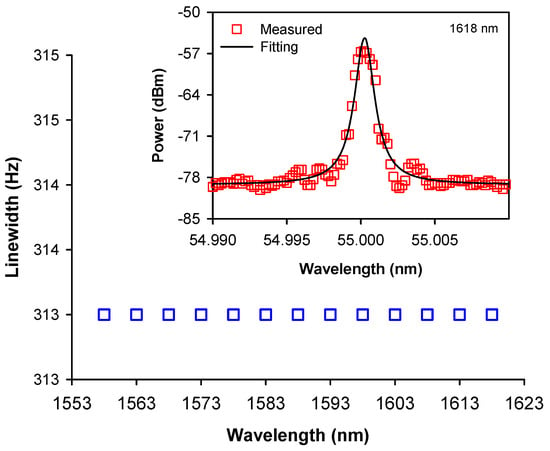
Figure 6.
Attained 3 dB Lorentzian linewidth by self-heterodyne method in the entire wavelength span from 1558.0 to 1618.0 nm, as shown by the blue square symbols. The top diagram is the electrical spectrum measured and fitted at 1618.0 nm wavelength.
In addition, the steady output of each generated wavelength in the EDF laser structure is also a noteworthy cause. To realize the real instabilities of the first designed EDF laser configuration, we also applied thirteen selected output wavelengths with a 5 nm tuning step in the tunability bandwidth from 1558.0 to 1618.0 nm. As displayed in Figure 7, the output power and center wavelength fluctuations of the proposed EDF laser were also measured through a 40 min observation time. In the available tuning bandwidth, the largest and smallest variations in each output power and wavelength were between 0.47 (at 1558.0 nm) and 0.08 dB (at 1618.0 nm), and between 0.032 (at 1608.0 nm) and 0.008 nm (at 1573.0 nm), respectively, as seen in Figure 7. Therefore, this demonstrated that the L-band EDF laser structure can achieve high stability in output power and center wavelength over the whole wavelength-adjusting bandwidth.
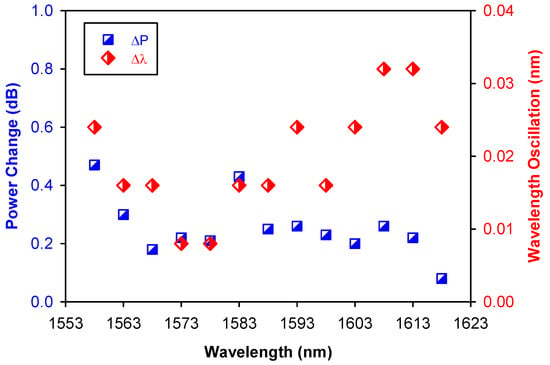
Figure 7.
Measured fluctuations in output power and center wavelength in the first proposed EDF laser are in the full tuning range through 40 min observation.
4. Second EDF Laser Experiment
In the next experiment, we swapped the placement of the EDF SA filter and SMF-induced feedback RB injection to test the output quality based on the experimental setup of Figure 1. This second laser configuration meant that the lasing wavelength passes through the 2 m EDF, 100 m SMF and then enters the FRM for round-trip propagation. In the experiment, the second EDF laser configuration achieves the same wavelength-adjusting bandwidth from 1558.0 to 1618.0 nm as the first laser. Figure 8 exhibits the detected optical spectrum of the second fiber laser at the selected wavelength of 1558.0, 1573.0, 1588.0, 1603.0, and 1618.0 nm through the OSA, respectively. Moreover, the observed output spectra and features of the second EDF laser were similar to those in Figure 2. In the same way, we also observed that the lasing wavelength at 1558.0 nm had high ASE noise after the wavelength of 1568 nm, as shown in Figure 8. To understand the output characteristics of the second EDF laser, the output power, OSNR, 3 dB linewidth, and instability over the effective operation, bandwidths were also executed and discussed using the same measurement method.
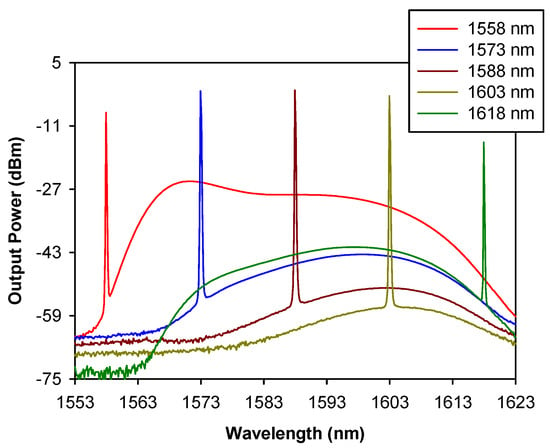
Figure 8.
Observed output spectra of second proposed EDF laser over the whole wavelength-tuning range from 1558.0 to 1618.0 nm.
First, the output power and the OSNR of the second proposed EDF laser were measured in the ranges of −14.17 to 1.74 dBm and 49.09 to 68.71 dB, as exhibited in Figure 9a and Figure 9b, respectively. The second fiber laser system could also reach a flat power output scale [ΔP = 1.1 dB (Pout = 0.64~1.74 dBm)] over a wavelength bandwidth from 1568.0 to 1598.0 nm (BW = 30 nm) with the corresponding OSNR between 61.72 and 68.71 dB, as exhibited in Figure 9a,b. The above results were also similar to those obtained using the first EDF laser. Moreover, it was also verified that the second fiber laser has stable SLM output through self-homodyne setup over the entire tuning bandwidth through the delayed self-homodyne observation. And the SLM output results obtained were the same as for the first EDF laser.
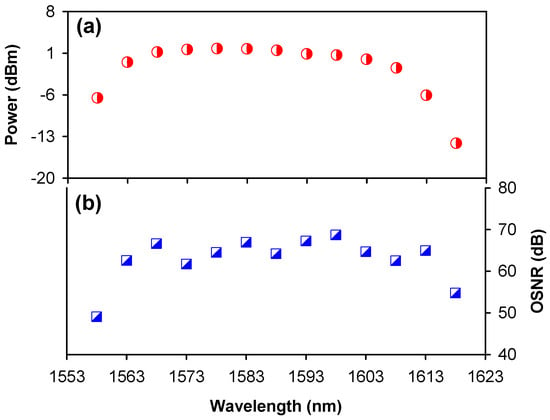
Figure 9.
(a) Detected output power and (b) OSNR of the second EDF laser in the whole tuning range, respectively.
Then, to understand the obtained linewidth of the second fiber laser, the self-heterodyne and Lorentzian curves were applied for measurement. We also used the 1618.0 nm wavelength for the linewidth measurement via the self-heterodyne first. Figure 10a shows the measured linewidth profile and Lorentzian curve of the electrical spectrum when the shift frequency (fshift) of 55 MHz was added to AOM. Thus, the 3 dB Lorentzian linewidth of 313 Hz could be obtained through fitting. In the observation, the other 3 dB linewidths of the second laser were all 313 Hz under the Lorentzian fit, as displayed in Figure 10b. As stated above, the first and second EDF laser configurations had the same 3 dB linewidth of 313 Hz. However, there were some differences in other output characteristics.
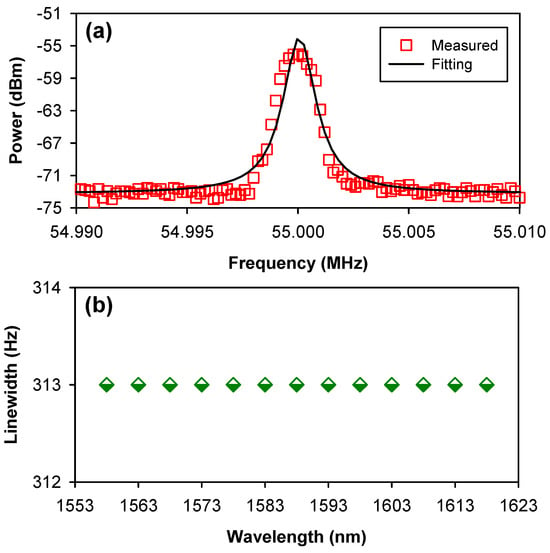
Figure 10.
(a) Measured and fitted output electrical spectrum at the wavelength of 1618.0 nm by self-heterodyne method. (b) Obtained 3 dB Lorentzian linewidth in the whole wavelength range from 1558.0 to 1618.0 nm.
Next, we also performed and discussed the output stabilities of power and center wavelength in the second EDF laser over the wavelength-adjusting scale from 1558.0 to 1618.0 nm during a short-term monitoring of 40 min, when the same thirteen output wavelengths were employed. As seen in Figure 11, the fluctuations in output power and center wavelength observed were between 0.07 (at 1573, 1608, and 1618 nm) and 0.22 dB (at 1603 nm) and 0.008 (at 1563, 1568, 1583, 1593, 1598, 1608 and 1613 nm) and 0.024 nm (at 1558 and 1618 nm), respectively, during the 40 min measurement period.

Figure 11.
Measured fluctuations in output power and center wavelength of the second EDF laser in the whole tuning range.
In this study, the corresponding output features of the first and second EDF lasers are displayed in Table 1 for comparison over the achievable wavelength bandwidth. As seen in Table 1, the obtained 3 dB linewidths of the first and second EDF lasers were all the same. Furthermore, the power output fluctuation of the first EDF laser (ΔP = 1.01 dB) was better than that of the second one (ΔP = 1.1 dB) over the available wavelength bandwidth from 1558.0 to 1598.0 nm. Comparing the two presented EDF laser architectures, we found that the output characteristics of the second fiber laser appear to be better than those of the first laser. As a result, we can choose the second EDF laser configuration to attain the best output performance.

Table 1.
Comparison of corresponding output characteristics of first and second EDF lasers.
5. Conclusions
In this work, an EDF ring laser was proposed and experimentally tested. To accomplish the stable SLM and narrow linewidth characteristics, the cascaded RB feedback injection and unpumped EDF-based SA were added to the ring cavity to produce two EDF laser structures. According to the measured results, the second EDF laser was better than the first. In the second EDF laser configuration, the lasing wavelength passed through the cascaded 2 m EDF-based SA and 100 m SMF-induced RB and then entered the FRM for round-trip propagation. Here, the output power and OSNR of the second EDF laser were between −14.17 and 1.74 dBm and 49.09 and 68.71 dB, respectively, in the wavelength scope from 1558.0 to 1618.0 nm (60 nm wavelength tunable bandwidth). Moreover, all the measured 3 dB Lorentzian linewidths for each output wavelength were 313 Hz. The second fiber laser also achieved a flat power output range from 1568.0 to 1598.0 nm with ΔP of 1.1 dB (output power was from 0.64 to 1.74 dBm). In addition, the output instabilities of power and center wavelength over the achievable tuning bandwidth were accomplished within 0.22 dB and 0.024 nm, respectively, through a short-term observation of 40 min. As a result, the designed L-band EDF ring laser achieved the output qualities of narrow sub-kHz linewidth, flat power output range, wide tunability bandwidth, high OSNR, and output stability.
Author Contributions
Conceptualization, C.-H.Y. and C.-W.C.; Investigation, L.-Y.C., Y.-T.L., C.-Y.L., K.-M.C. and J.-H.C.; Data curation, L.-Y.C., Y.-T.L., C.-Y.L. and K.-M.C.; Writing—original draft preparation, C.-H.Y. and C.-W.C.; Writing—review and editing, C.-H.Y.; Supervision, C.-W.C. and J.-H.C.; Funding acquisition, C.-H.Y. All authors have read and agreed to the published version of the manuscript.
Funding
This paper was supported by the National Science and Technology Council, Taiwan, NSTC-112-2221-E-035-059-MY3.
Institutional Review Board Statement
Not applicable.
Informed Consent Statement
Not applicable.
Data Availability Statement
Data are contained within the article.
Conflicts of Interest
The authors declare no conflict of interest.
References
- Asseh, A.; Storoy, H.; Kringlebotn, J.T.; Margulis, W.; Sahlgren, B.; Sandgren, S.; Stubbe, R.; Edwall, G. 10 cm Yb3+ DFB fiber laser with permanent phase shifted grating. Electron. Lett. 1995, 31, 969–970. [Google Scholar] [CrossRef]
- Ball, G.A.; Morey, W.W. Continuously tunable single-mode erbium fiber laser. Opt. Lett. 1992, 17, 420–422. [Google Scholar] [CrossRef]
- Shang, J.; Wang, Z.; Li, S.; Zhu, E.; Yu, S.; Qiao, Y. Tunable narrow linewidth linear cavity fiber laser based on a one-way round-trip structure. Opt. Fiber Technol. 2022, 68, 102780. [Google Scholar] [CrossRef]
- Yin, G.; Saxena, B.; Bao, X. Tunable Er-doped fiber ring laser with single longitudinal mode operation based on Rayleigh backscattering in single mode fiber. Opt. Express 2011, 19, 25981–25989. [Google Scholar] [CrossRef]
- Yao, Y.; Chen, X.; Dai, Y.; Xie, S. Dual-wavelength erbium-doped fiber laser with a simple linear cavity and its application in microwave generation. IEEE Photon. Technol. Lett. 2005, 18, 187–189. [Google Scholar] [CrossRef]
- Wang, Z.; Shang, J.; Li, S.; Mu, K.; Qiao, Y.; Yu, S. All-polarization maintaining single-longitudinal-mode fiber laser with ultra-high OSNR, sub-kHz linewidth and extremely high stability. Opt. Laser Technol. 2021, 141, 107135. [Google Scholar] [CrossRef]
- Li, J.; Zhang, Z.; Gan, J.; Zhang, Z.; Heng, X.; Zhou, K.; Zhao, H.; Xu, S.; Yang, Z. Influence of laser linewidth on phase-OTDR system based on heterodyne detection. J. Lightw. Technol. 2019, 37, 2641–2647. [Google Scholar] [CrossRef]
- Feng, S.; Mao, Q.; Tian, Y.; Ma, Y.; Li, W.; Wei, L. Widely tunable single longitudinal mode fiber laser with cascaded fiber-ring secondary cavity. IEEE Photonics Technol. Lett. 2013, 25, 323–326. [Google Scholar] [CrossRef]
- Liu, Y.; Dong, X.; Shum, P.; Yuan, S.; Kai, G.; Dong, X. Stable room-temperature multi-wavelength lasing realization in ordinary erbium-doped fiber loop lasers. Opt. Express 2006, 14, 9293–9298. [Google Scholar] [CrossRef]
- Yeh, C.-H.; Liu, L.-H.; Ko, H.-S.; Lai, Y.-T.; Chow, C.-W. A Selectable single-mode erbium fiber laser with Mach-Zehnder interferometer and Rayleigh injection scheme. IEEE Photon. J. 2022, 14, 1532904. [Google Scholar] [CrossRef]
- Peng, P.-C.; Lin, J.-H.; Tseng, H.-Y.; Chi, S. Intensity and wavelength-division multiplexing FBG sensor system using a tunable multiport fiber ring laser. IEEE Photon. Technol. Lett. 2004, 16, 230–232. [Google Scholar] [CrossRef]
- Cheng, X.P.; Shum, P.; Tse, C.H.; Zhou, J.L.; Tang, M.; Tan, W.C.; Wu, R.F.; Zhang, J. Single-longitudinal-mode erbium-doped fiber ring laser based on high finesse fiber Bragg grating Fabry-Perot etalon. IEEE Photon. Technol. Lett. 2008, 20, 976–978. [Google Scholar] [CrossRef]
- Lee, H.-C.; Lee, Y.-W.; Chang, J.-S.; Liaw, S.-K. Single-longitude-mode fiber laser implementation by using only two subring cavities in serial/parallel connection. Fiber Integr. Opt. 2019, 38, 236–246. [Google Scholar] [CrossRef]
- Li, L.; Zhang, M.; Liu, Y.; Li, Y.; Wang, Y. Stable single-longitudinal-mode erbium-doped fiber laser with narrow linewidth utilizing parallel fiber ring resonator incorporating saturable absorber and fiber Bragg grating. Appl. Opt. 2015, 54, 4001–4005. [Google Scholar] [CrossRef]
- Lu, B.; Kang, J.; Qi, X.Y.; Feng, X.Q.; Hou, L.; Jiang, M.; Chen, H.W.; Wang, Y.; Wang, K.L.; Bai, J.T. High-stability broadband wavelength-tunable single-frequency ytterbium-doped all-fiber compound ring cavity. IEEE Photon. J. 2017, 9, 1501708. [Google Scholar] [CrossRef]
- Zou, H.; Lou, S.; Yin, G.; Su, W. Switchable dual-wavelength PM-EDF ring laser based on a novel filter. IEEE Photon. Technol. Lett. 2013, 25, 1003–1006. [Google Scholar] [CrossRef]
- Gu, J.; Yang, Y.; Liu, M.; Zhang, J.; Wang, X.; Yuan, Y.; Yao, Y. A switchable and stable single-longitudinal-mode, dual-wavelength erbium-doped fiber laser assisted by Rayleigh backscattering in tapered fiber. J. Appl. Phys. 2015, 118, 103107. [Google Scholar] [CrossRef]
- He, W.; Zhu, L.; Dong, M.; Lou, X.; Luo, F. Wavelength-switchable and stable-ring-cavity, erbium-doped fiber laser based on Mach-Zehnder interferometer and tunable filter. Laser Phys. Lett. 2018, 28, 045104. [Google Scholar] [CrossRef]
- Liaw, S.-K.; Hsu, K.-C.; Chen, N.-K. Tunable erbium-doped fiber lasers using various inline fiber filters. Engineering 2010, 2, 2562. [Google Scholar] [CrossRef][Green Version]
- Wang, L.; Dong, X.; Shum, P.P.; Su, H. Tunable erbium-doped fiber laser based on random distributed feedback. IEEE Photon. J. 2014, 6, 1501705. [Google Scholar]
- Yamashita, S. Widely tunable erbium-doped fiber ring laser covering both C-band and L-band. IEEE J. Sel. Top. Quantum Electron. 2001, 7, 41–43. [Google Scholar] [CrossRef]
- Wei, D.; Feng, T.; Sun, W.; Yan, F.; Yao, X.S. Widely wavelength-swept single-longitudinal-mode fiber laser with ultra-narrow linewidth in C+L-band. IEEE Photon. J. 2022, 14, 7134810. [Google Scholar] [CrossRef]
- Yeh, C.-H.; Chi, S. A broadband fiber ring laser technique with stable and tunable signal-frequency operation. Opt. Express 2005, 13, 5240–5244. [Google Scholar] [CrossRef]
- Li, Y.; Huang, L.; Gao, L.; Lan, T.; Cao, Y.; Ikechukwu, I.P.; Shi, L.; Liu, Y.; Li, F.; Zhu, T. Optically controlled tunable ultra-narrow linewidth fiber laser with Rayleigh backscattering and saturable absorption ring. Opt. Express 2018, 26, 26896–26906. [Google Scholar] [CrossRef] [PubMed]
Disclaimer/Publisher’s Note: The statements, opinions and data contained in all publications are solely those of the individual author(s) and contributor(s) and not of MDPI and/or the editor(s). MDPI and/or the editor(s) disclaim responsibility for any injury to people or property resulting from any ideas, methods, instructions or products referred to in the content. |
© 2023 by the authors. Licensee MDPI, Basel, Switzerland. This article is an open access article distributed under the terms and conditions of the Creative Commons Attribution (CC BY) license (https://creativecommons.org/licenses/by/4.0/).